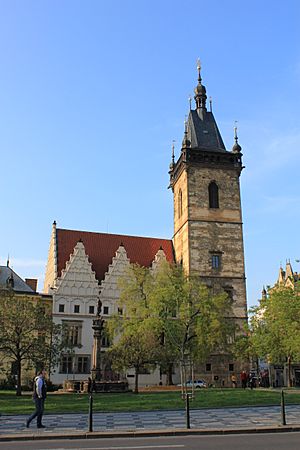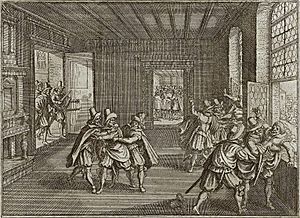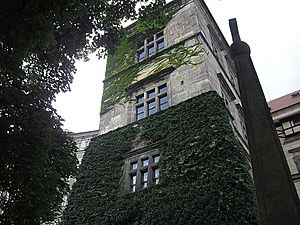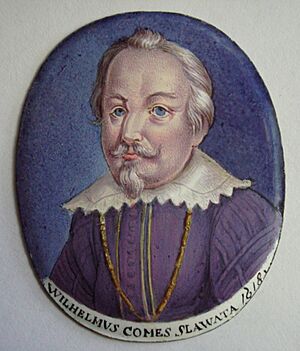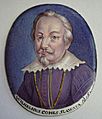Defenestration of Prague facts for kids
The "Defenestration of Prague" is a name for three important events in the history of Prague, a city in the Czech Republic. A "defenestration" means throwing someone or something out of a window. These events were not just random acts; they were often connected to big political or religious changes and had a huge impact on history.
Contents
What is Defenestration?
The word "defenestration" comes from the Latin words de- (meaning "out of") and fenestra (meaning "window"). So, it literally means "out of the window." In history, throwing someone out of a window was sometimes a way to show strong anger or to get rid of someone in a very public and dramatic way.
The First Defenestration (1419)
The first time this happened in Prague was on July 30, 1419. This event was a major spark for the Hussite Wars, which were religious wars in Bohemia (now part of the Czech Republic).
Why it Happened
At that time, there was a lot of tension between the followers of Jan Hus (called Hussites) and the Catholic Church. Jan Hus was a religious reformer who wanted to change some things about the Church. He was later executed, which made his followers very angry.
On that day, a group of Hussites, led by a priest named Jan Želivský, marched to the New Town Hall in Prague. They were protesting because some Hussite prisoners were being held there.
What Happened
When the Hussites arrived, they demanded the release of the prisoners. Things quickly got out of control. Someone from inside the town hall threw a stone at the crowd. In response, the angry Hussites stormed the building. They grabbed the mayor and several town council members and threw them out of the windows. They fell onto spears and other weapons held by the crowd below, and they died.
Its Impact
This violent act shocked everyone and directly led to the start of the Hussite Wars. These wars lasted for many years and changed the religious and political landscape of Bohemia.
The Second Defenestration (1618)
The second and most famous defenestration happened on May 23, 1618. This event is often seen as the start of the Thirty Years' War, one of the longest and most destructive wars in European history.
Why it Happened
By 1618, Bohemia was part of the Habsburg Monarchy, which was ruled by Holy Roman Emperors who were strong Catholics. Many people in Bohemia were Protestants, and they felt that their religious freedom was being taken away. The Emperor Matthias had promised Protestants certain rights, but his officials were not always respecting these promises.
Protestant nobles in Bohemia were very unhappy with two Catholic officials, Jaroslav Bořita of Martinice and Vilem Slavata of Chlum, who they believed were violating their rights.
What Happened
A group of Protestant nobles went to Prague Castle, where the royal offices were located. They confronted the two Catholic officials, Jaroslav Bořita of Martinice and Vilem Slavata of Chlum, along with a secretary named Philip Fabricius. After a heated argument, the Protestant nobles found the officials guilty of breaking the Emperor's promises. They then threw all three men out of a window in the castle.
Miraculously, all three men survived the fall, landing in a pile of manure (animal waste) below. They managed to escape and spread the word about what had happened.
Its Impact
Even though the officials survived, this act was a clear challenge to the Emperor's authority. It led to a rebellion in Bohemia, which quickly grew into the Thirty Years' War. This war involved most of Europe and caused immense destruction and loss of life across the continent. It changed the balance of power in Europe and had a lasting impact on religious freedom.
The Third Defenestration (1948)
The third event sometimes called a "defenestration" happened on March 10, 1948. This was the death of Jan Masaryk, who was the foreign minister of Czechoslovakia (now the Czech Republic and Slovakia).
Why it Happened
After World War II, Czechoslovakia was caught between the influence of the Soviet Union and Western countries. The Communist Party was gaining power in Czechoslovakia, supported by the Soviet Union. Jan Masaryk was a well-known politician who was not a Communist, and he represented a link to the country's democratic past.
What Happened
Jan Masaryk was found dead in the courtyard of the Foreign Ministry building in Prague. He was dressed in his pajamas. The official report said he had committed suicide by jumping out of a window.
Its Impact
However, many people, both at the time and since, believed that Masaryk was murdered by the Communists who were taking over the government. His death happened just after the Communist Party had taken full control of Czechoslovakia in what is known as the "February Coup." His death removed a key figure who might have resisted the new Communist rule. It became a symbol of the end of democracy in Czechoslovakia and the beginning of a long period of Communist rule under Soviet influence.
Images for kids
See also
 In Spanish: Defenestraciones de Praga para niños
In Spanish: Defenestraciones de Praga para niños


